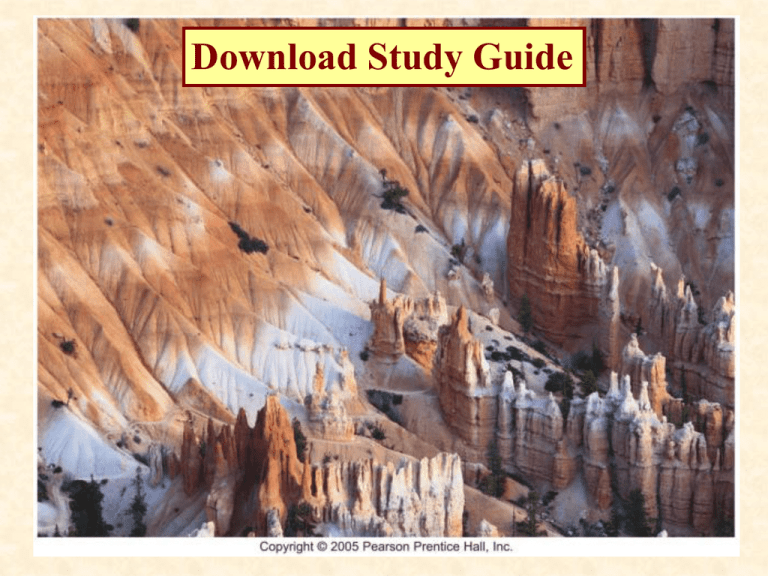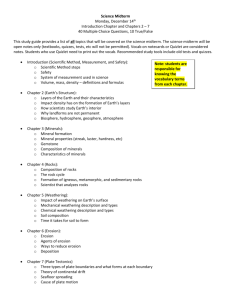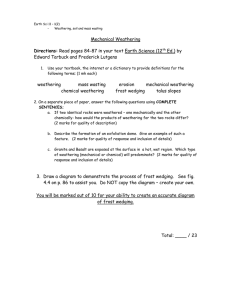Weathering
advertisement

Download Study Guide Weathering of Rocks Hoodoos Weathering in the Rock Cycle And Sedimentary Rocks Metamorphic Rocks Weathering/Erosion Heat and Pressure Magma Sediment Igneous Rocks Three Dynamic Processes of Breaking and Removing rock 1. Weathering - the disintegration and decomposition of rock at or near the surface 2. Erosion 3. Mass Wasting Types of Weathering Mechanical – physical breakdown of rocks. Chemical – decomposition of rocks by chemical reactions. Mechanical Weathering makes smaller pieces Mechanical Weathering 1. Frost Wedging 2. Salt Wedging 3. Biological Wedging 4. Unloading 5. Thermal Expansion Frost Wedging Types of Mechanical Weathering Frost wedging – water penetrates into cracks, expands when it freezes. Must have: • Adequate moisture • Cracks in rocks • Freeze/thaw cycles Salt Wedging Types of Mechanical Weathering Salt wedging – growth of minerals in cracks • Desert environments • Water evaporates, ions in solution combine to form minerals Biological Wedging Types of Mechanical Weathering Biological wedging – plant roots penetrate into cracks causing cracks to widen. Must have: • Climate hospitable for plants • Adequate moisture and temperature Unloading removal of pressure of deep burial Unloading Sheeting Thermal expansion •repeated daily heating and cooling of rock; •heat causes expansion; cooling causes contraction. Chemical Weathering Chemical alteration of minerals. Results in new minerals and ions in solution. Water and acid are essential. Types of Chemical Weathering Hydrolysis - any reaction in which water participates. 1. Ion Exchange – H+ replaces other cations. 2. Dissolution - mineral completely dissolves, leaving only ions in solution. 3. Oxidation - reaction in which elements gain or lose electrons (example: rust). Carbon dioxide reacts with water to form carbonic acid (Equation 1). Carbonic acid then dissociates to give the hydrogen ion (H+) and the hydrogen carbonate ion (HCO3-) (Equation 2). The ability of H2CO3 to deliver H+ is what classifies this molecule as an acid, thus lowering the pH of a solution. Ion Exchange Carbon Dioxide + Rain Becomes Acid Dissolves Minerals Leaves ----Clay Carries away--- Ions Silica Dissolution Certain minerals dissolve in water Oxidation Iron Silicate dissolves Iron Oxidizes Oxidized Iron combines with Water Leaves Iron Oxide Relative susceptibility To weathering Mineral Residual Products Material in Solution Quartz quartz grains silica Feldspar clay minerals silica, K +, Na+, Ca2+ Amphibole (hornblende) clay minerals, limonite, hematite silica, Mg2+, Ca2+ Olivine limonite, hematite silica, Mg2+ Factors influencing Weathering Rates 1. Rock Structures – chemical/mineral composition, Physical features 2. Topography 3. Climate Spheroidal Weathering Elephant Rock State Park, MO Results of Weathering Result of Weathering Regolith – a loose layer of broken rock and mineral fragments. Dissolved ions Benefits of Weathering • Creates soil • Produces clay, sand, and gravel • Produces minerals Erosion and Transport Erosion – transport of unconsolidated Earth material from one place to another Modes of Transport 1. Water 2. Wind 3. Ice 4. Gravity Erosion by Water Removal of regolith Loose material is easily picked up by flowing water. Downcutting of stream channel Sediments abrade stream bottom, dislodging pieces of bedrock Headward Erosion Headward Erosion Transport by Water Saltation – particles move downstream in short jumps. Bed load – material transported by saltation Suspended load – material carried in water for long distances. Transport by Water Erosion by Wind Deflation - Loose material can be picked up by wind Abrasion - Windblown sediments can "sandblast" rocks. Erosion by Wind Abrasion – airborne particles chip off small fragments of other rocks. Transport by Wind Same processes as water – saltation, bed load and suspended load. Transport by Wind Deflation – removal of small, loose particles. Can form desert pavement. Erosion by Ice Plowing – loose material is "bulldozed" Plucking – pieces of bedrock are pried loose. Abrasion – pieces of rock in the ice grind against bedrock below. Abrasion and Plucking Transport by Ice Particle size and method of Transport Water – smallest particles to small boulders. Wind – smallest particles to sand size. Ice – smallest particles to boulders as big as a house. Mass Wasting Transport by gravity The downslope movement of unconsolidated Earth material due to gravity. •What is mass wasting? •What causes mass wasting? •Why is it important to know about mass wasting? •What can be done to control mass wasting? Watch for fallen Rocks Slope Failures - Slump Creep Creep Stability reduced by: 1. Adding water to the material of a slope 2. Increasing the steepness of the slope 3. Removing material from the lower part of the slope 4. Earthquakes 5. Removal of vegetation •What is mass wasting? •What causes mass wasting? •Why is it important to know about mass wasting? •What can be done to control mass wasting? Engineering Solutions Rock Nets Soil Nailing Avalanche Barriers Switzerland






